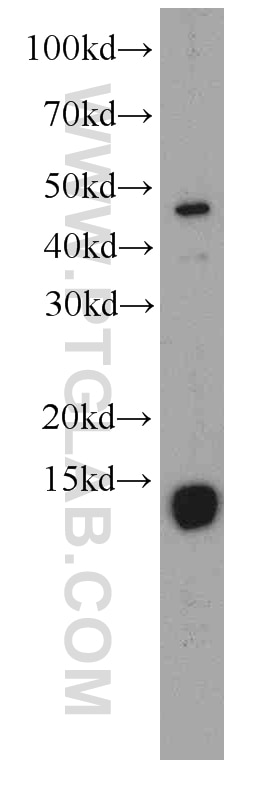Published Applications
| WB | See 1 publications below |
| IHC | See 2 publications below |
Product Information
66086-1-Ig targets FHIT in WB, IHC, ELISA applications and shows reactivity with human samples.
| Tested Reactivity | human |
| Cited Reactivity | human |
| Host / Isotype | Mouse / IgG1 |
| Class | Monoclonal |
| Type | Antibody |
| Immunogen | FHIT fusion protein Ag14471 Predict reactive species |
| Full Name | fragile histidine triad gene |
| Calculated Molecular Weight | 147 aa, 17 kDa |
| Observed Molecular Weight | 17 kDa |
| GenBank Accession Number | BC032336 |
| Gene Symbol | FHIT |
| Gene ID (NCBI) | 2272 |
| Conjugate | Unconjugated |
| Form | Liquid |
| Purification Method | Protein G purification |
| UNIPROT ID | P49789 |
| Storage Buffer | PBS with 0.02% sodium azide and 50% glycerol, pH 7.3. |
| Storage Conditions | Store at -20°C. Stable for one year after shipment. Aliquoting is unnecessary for -20oC storage. 20ul sizes contain 0.1% BSA. |
Background Information
The candidate tumor suppressor gene, FHIT(Fragile histidine triad protein), encompasses the common human chromosomal fragile site at 3p14.2, the hereditary renal cancer translocation breakpoint, and cancer cell homozygous deletions. Fhit hydrolyzes dinucleotide 5',5'''-P1,P3-triphosphate in vitro and mutation of a central histidine abolishes hydrolase activity(PMID:9391102). FHIT has a major role in regulating beta-catenin-mediated gene transcription.
Protocols
| Product Specific Protocols | |
|---|---|
| WB protocol for FHIT antibody 66086-1-Ig | Download protocol |
| Standard Protocols | |
|---|---|
| Click here to view our Standard Protocols |
Publications
| Species | Application | Title |
|---|---|---|
Cancer Biomark FHIT and C-MYC expression in cervical histology and cytology as biomarkers for detecting high-grade intraepithelial neoplasia in human papillomavirus-positive women. | ||
Int J Clin Exp Pathol Upregulation of FHIT gene expression in endometrial carcinoma by RNA activation. |



